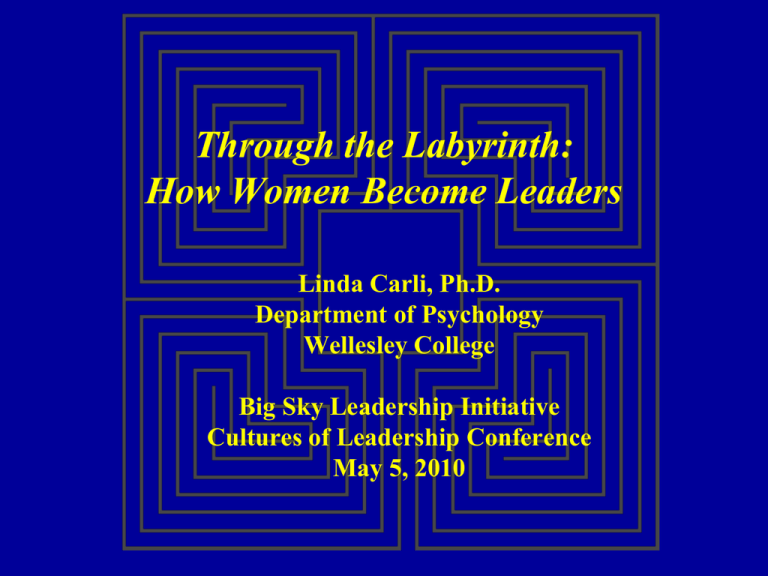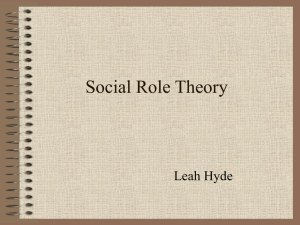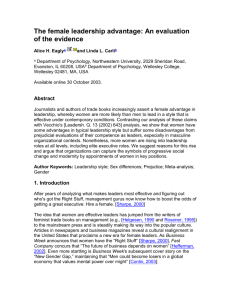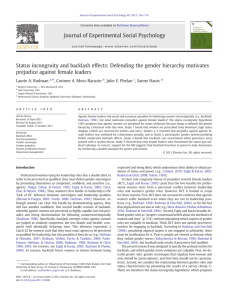
Through the Labyrinth:
How Women Become Leaders
Linda Carli, Ph.D.
Department of Psychology
Wellesley College
Big Sky Leadership Initiative
Cultures of Leadership Conference
May 5, 2010
Is there still a glass ceiling?
• A single obstacle
• At the pinnacle of women’s careers
• The same for all women
• Completely impermeable
- But there are multiple obstacles
- Some occur early in careers
- Paths to leadership vary
- And some women have advanced
(Wall Street Journal, 1986)
More women are well-educated
Percentage of degrees awarded to women in the
United States, 1900-2008
(bls.gov)
Master's
Doctor's
70
60
50
40
30
20
0
0
0
0
0
0
0
0
5
0
5
0
5
0
5
8
191
192
193
194
195
196
197
197
198
198
199
199
200
200
200
10
0
190
Percentage going to women
Bachelor's
More women have jobs
Labor force participation of men and women in the
United States, 1940-2009
(bls.gov)
Men
100
90
80
70
60
50
40
30
20
10
0
19 4
0
19 4
3
19 4
6
19 4
9
19 5
2
19 5
5
19 5
8
19 6
1
19 6
4
19 6
7
19 7
0
19 7
3
19 7
6
19 7
9
19 8
2
19 8
5
19 8
8
19 9
1
19 9
4
19 9
7
20 0
0
20 0
3
20 0
6
20 0
9
Percentage
Women
More women are in management
Percentage of managers who are women and men in
the United States—1983-2009
Women
(bls.gov)
Men
80
60
50
40
30
20
10
20
09
20
07
20
05
20
03
20
01
19
99
19
97
19
95
19
93
19
91
19
89
19
87
19
85
0
19
83
Percentage
70
Women are earning more
Median weekly earnings of full-time & salaried employees
in the United States, in 2008 dollars, 1979-2008
(bls.gov)
Men
Women
850
750
650
550
450
350
250
1979 1983 1987 1991 1995 1999 2003 2007
But equality has not been achieved
• Income gap remains
• Slower advancement for women
• Few women at the top of biggest corporations
Organizational leadership in USA, 2009
(bls.gov;
Catalyst, 2009, 2010; Fortune, 2010)
Women
Men
100
90
Percentage
80
70
60
50
40
30
20
10
42 58
25 75
16 84
15 85
6 94
3 97
Managers
CEOs
Fortune 500
Corporate
Officers
Fortune 500
Board
Members
Fortune 500
Top Earners
Fortune 500
CEOs
0
Leadership
(Harvard Business Review, 2007)
What are the obstacles that form the labyrinth?
Do women lack the desire for leadership or the traits of
a good leader?
• No
• Women and men in similar positions do not differ in
their desire for advancement and leadership
(Konrad et. al., 2000)
• Women and men do not differ in the personality
traits associated with effective leadership
(Halpern, 2001; Schmitt, et. al.
2008)
- Extraversion
- Intelligence
(Judge, et. al., 2002)
(Judge, Colbert, & Ilies, 2004)
What about family responsibilities?
Women take more career breaks for family and more
often work part-time
(Bianchi, Robinson, & Milkie, 2006;)
Weekly hours of housework
Married Women
Married Men
40
Hours
30
20
10
0
1965
1975
1985
Year
1995
2005
What about family responsibilities?
Women take more career breaks for family and more
often work part-time
(Bianchi, Robinson, & Milkie, 2006)
Weekly hours of childcare
Married Mothers
Married Fathers
14
Hours
12
10
8
6
4
2
0
1965
1975
1985
Year
1995
2000
What about family responsibilities?
Women take more career breaks for family and more
often work part-time
(Galinsky et al., 2003)
Executives with Stay-at-Home or
Employed Spouses
Female executives
Male executives
Percentage
80
60
40
20
0
Stay-at-home Spouse
Employed Spouse
Organizational obstacles
• Lack of social capital – less access to powerful networks
and mentors
(e.g., Forret & Dougherty, 2004; McPherson, Smith-Lovin, & Cook, 2001)
• Fewer offers of appropriately challenging assignments
– line management, travel, and relocations
(e.g., Catalyst, 2004; Lyness & Thompson, 2000)
- Glass cliff
(e.g., Haslam & Ryan, 2008; Ryan & Haslam, 2007)
One major obstacle: Gender stereotypes
• Men seen as more agentic (for example, competent, leaderlike, assertive, in charge, strong, directive)
• Women seen as more communal (for example, warm,
supportive, helpful, sympathetic, kind)
• And leaders?
- Think-manager think-male studies: Studies comparing the
traits of leaders with the traits of men and women (e.g., Schein, 1973)
- Studies comparing the agentic vs communal traits of
leaders (e.g., Powell & Butterfield, 1989)
• And what are leaders and managers seen as?
- Agentic
Association of leadership with stereotypical traits
of men and women
(Koenig et al, 2010)
Correlation coefficient
Male Traits
Female Traits
0.8
0.7
0.6
0.5
0.4
0.3
0.2
0.1
0
Overall
By Men
By Women
Doubts about women’s agency and competence
• To be considered exceptional, women must exhibit
higher levels of performance than men do
(e.g., Biernat &
Kobrynowicz, 1997; Foschi, 2000)
• Real expertise is less likely to be recognized in
women than in men
(e.g., Propp, 1995; Thomas-Hunt & Phillips, 2004)
And what about the stereotype that women are
communal?
• Women not only are thought to be communal,
• they have to be
The demand for communal behavior
• Women are penalized more than men for being
agentic
-
Disagreeing (e.g., Carli, 2006)
Negotiating (e.g., Bowles, Babcock, & Lai, 2007; Stuhlmacher & Walters, 1999)
Self-promoting (e.g., Carli, 2006; Wosinska et al., 1996)
Command-and-control leadership (Eagly, Makhijani, & Klonsky, 1992).
• Women who succeed in masculine domains are
thought to lack communion & are disliked
(e.g., Heilman, et. Al.,
2004; Yoder & Schleicher, 1996)
• Men receive benefits (gaining approval or
promotion) for being helpful but women do not
Allen, 2006; Heilman & Chen, 2005)
(e.g.,
A double bind for women leaders
• To be a good leader, women must overcome doubts
about their agency by performing exceptionally well
and being highly agentic.
- But very competent and agentic women may be
seen as lacking communion and not well liked.
• To be a good woman, women must be communal by
being warm, helpful, and supportive.
- But nice communal women may be seen as lacking
agency and competence, and considered weak
ineffective leaders.
In the chat rooms around Silicon
Valley, from the time I arrived and
until long after I left HP, I was
routinely referred to as a ‘bimbo,’ or
a ‘bitch’—too soft or too hard, and
presumptuous, besides.
Carly Fiorina, 2006
former CEO Hewlett-Packard
In Tough Choices
The double-bind and stereotypes lead to discrimination
• Meta-analysis of résumé experiments
Men favored
(Davison & Burke, 2000)
Women favored
0.4
Effect size in d
0.3
0.2
0.1
0
-0.1
-0.2
-0.3
Masculine Jobs
Gender-Neutral Jobs
Feminine Jobs
Other evidence of discrimination
• Studies assess whether the gender gaps in
income and promotion disappear when
controlling for human capital variables
2006; Smith, 2002)
-
Years of employment
Breaks in employment
Part-time or full time employment
Education
Overtime hours
- Gender gaps remain
(e.g., Blau & Kahn,
What can women do to overcome some of
the obstacles that form the labyrinth?
• Build social capital
– Networking, mentors
• Blend agency & communion
– Lead with a mix of masculine & feminine
qualities
– What type of leadership might incorporate
agency and communion?
Transformational Leadership
• Idealized Influence (Attributes)
- Motivating respect and pride from association with the
leader
• Idealized Influence (Behavior)
- Communicating values, purpose, and importance of
organization’s mission
• Inspirational Motivation
- Displaying optimism and excitement about goals and
future states
• Intellectual Stimulation
- Examining new perspectives for solving problems and
completing tasks
• Individualized Consideration
- Focusing on development and mentoring of followers and
attending to their individual needs
Transformational leadership is often contrasted
with Transactional and Laissez-faire Leadership
Transactional Leadership
• Contingent Reward
- Rewarding followers for satisfactory performance
• Active Management-by-Exception
- Attending to followers’ mistakes and failures
• Passive Management-by-Exception
- Waiting until problems become severe before
attending to them
Laissez-Faire Leadership
- Is absent and uninvolved during critical junctures
Which styles are effective?
(Judge & Piccolo, 2004)
Transformational
• Idealized Influence (Attributes)
• Idealized Influence (Behavior)
• Inspirational Motivation
• Intellectual Stimulation
• Individualized Consideration
More
Effective
Styles
Transactional
• Contingent Reward
• Active Management by Exception
• Passive Management by Exception
Laissez-Faire
Less
Effective
Styles
Do women and men differ in these styles?
(Eagly, Johannesen-Schmidt, & van
Engen, 2003).
Transformational
• Idealized Influence (Attributes)
• Idealized Influence (Behavior)
• Inspirational Motivation
• Intellectual Stimulation
• Individualized Consideration
Women use
these
styles more
Transactional
• Contingent Reward
• Active Management by Exception
• Passive Management by Exception
Laissez-Faire
Men use
these
styles more
Advantages of having women leaders
• Women more often use transformational leadership
and contingent reward
• Diversity yields a greater range of perspectives and
points of view, which can enhance performance and
creativity (but also produce conflict & stress)
(e.g., Guzzo &
Dickson, 1996; van Knippenberg & Schippers, 2007)
• Studies predict financial performance from the % of
women among corporate officers and on boards of
directors
(e.g., Carter, Simkins, & Simpson, 2003; Krishnan & Park, 2005)
Organizational strategies to increase the
number of women leaders
(Kalev et al., 2006)
• Increase women’s social capital with networking
& mentoring programs
• Creating full-time diversity staff and multidepartment diversity committees to develop policy
and monitor outcomes
More organizational strategies
• Offer the same opportunities to women as men—line
management positions, travel, relocations, and other
appropriately challenging opportunities
• Increase representation of women
- Avoid placing women in token positions
- Having more visible female leaders shifts stereotypes
about leaders
A major shift in views about leadership
Good leadership is increasingly seen as requiring communal
qualities
We have teams of people, creative
people, and it is about keeping them
motivated, keeping them on track,
making sure that they are following
the vision. I am observing, watching
and encouraging and motivating . . . .
We try to set an agenda throughout
the company where everyone’s
opinion counts, and it’s nice to be
asked.
Rose Marie Bravo
Then CEO,
Burberry Group
In the media
Mike
Barack
Krzyzewski,
Obama understands
the Duke
basketball
that real coach
strength
andcomes
business
guru,
fromhas
a blending
some things
of the
to tell you
about
masculine
leadership:
and feminine.
For starters:
Release your
Christi
inner
Parsons
woman.
, 2008
In Chicago
MichaelTribune
Sokolove, 2006
In New York Times
By leadership experts and scholars:
Command-and-control leadership
has given way to a new approach,
often called an influence model of
leadership . . . The new leader persuades,
empowers, collaborates, and partners
David Gergen, 2005
Center for Public Leadership at the
Harvard Kennedy School of Government
By the Public:
Would vote for well-qualified woman presidential
candidate if nominated by own party (U.S. Polls)
Yes
No
100
90
80
Percent
70
60
50
40
30
20
10
0
1937 1945 1949 1955 1958 1959 1963 1967 1969 1971 1975 1978 1983 1984 1987 1998 2003 2006
Year
So what does the future hold for women leaders?
The changes in ideas
about leadership,
equating good
leadership with
communal qualities,
should continue to
advance women and
help women leaders
chart a path through
the labyrinth.
Thanks to my collaborator and
coauthor, Alice Eagly, our
students—who have helped us
in our research, and the many
scholars who have contributed
to our knowledge about women
leaders.
And thanks to you for your
interest in women’s leadership.
References
•
•
•
•
•
•
•
•
•
•
•
•
•
•
•
•
•
•
•
•
•
Allen, T. D. (2006). Rewarding good citizens: The relationship between citizenship behavior, gender, and organizational rewards. Journal of Applied Psychology, 36,
120–143.
Bianchi, S. M., Robinson, J. P., & Milkie, M. A. (2006). Changing rhythms of American family life. New York: Russell Sage Foundation.
Biernat, M. & Kobrynowicz, D. (1997). Gender- and race-based standards of competence: Lower minimum standards but higher ability standards for devalued
groups. Journal of Personality and Social Psychology, 72, 544–557.
Blau, F. D. & Kahn, L. M. (2006) The U.S. gender pay gap in the 1990s: Slow convergence. Industrial and Labor Relations Review, 60, 45-66.
Bowles, H., Babcock, L., & Lai, L. (2007). Social incentives for gender differences in the propensity to initiate negotiations: Sometimes it does hurt to ask.
Organizational Behavior and Human Decision Processes, 103, 84-103.
Carli, L. L. (2006, July). Gender and social influence: Women confront the double bind. Paper presented at the 26th International Conference of Applied Psychology,
Athens, Greece.
Carter, D. A., Simkins, B. J., & Simpson, W. G. (2003). Corporate governance, board diversity, and firm value. Financial Review, 38, 33–53.
Catalyst. (2004). Women and men in U.S. corporate leadership: Same workplace, different realities? Retrieved January 6, 2010 from
http://catalyst.org/file/74/women%20and%20men%20in%20u.s.%20corporate%20leadership%20same%20workplace,%20different%20realities.pdf.
Catalyst. (2009). Quick takes: Australia, Canada, South Africa and the United States. Retrieved January 6, 2010 from http://catalyst.org/publication/239/australiacanada-south-africa-united-states.
Catalyst. (2009). Quick takes: Women in U.S. management. Retrieved January 6, 2010 from http://catalyst.org/publication/206/women-in-us-management.
Davison, H. K., & Burke, M. J. (2000). Sex discrimination in simulated employment contexts: A meta-analytic investigation. Journal of Vocational Behavior, 56,
225-248.
Eagly, A. H., & Carli, L. L. (2007). Through the labyrinth: The truth about how women become leaders. Cambridge, MA: Harvard Business School Press.
Eagly, A. H., Johannesen-Schmidt, M. C., & van Engen, M. (2003). Transformational, transactional, and laissez-faire leadership styles: A meta-analysis comparing
women and men. Psychological Bulletin, 129, 569-591.
Eagly, A. H., Makhijani, M. G., & Klonsky, B. G. (1992). Gender and the evaluation of leaders: A meta-analysis. Psychological Bulletin, 111, 3-22.
Forret, M., & Dougherty, T. (2004). Networking behaviors and career outcomes: Differences for men and women? Journal of Organizational Behavior, 25, 419-437.
Fortune. (20010). Fortune 500 CEOs: Women on the rise. Retrieved January 4, 2010 from the Fortune Magazine website on
http://postcards.blogs.fortune.cnn.com/2009/04/20/fortune-500-ceos-women-on-the-rise/.
Foschi, M. (2000). Double standards for competence. Annual Review of Sociology, 26, 21-42.
Galinsky, E., Salmond, K., Bond, J. T., Kropf, M. B., Moore, M., & Harrington, B. (2003). Leaders in a global economy: A study of executive women and men. New
York: Families and Work Institute.
Guzzo, R., & Dickson, M. (1996). Teams in organizations: Recent research on performance and effectiveness. Annual Review of Psychology, 47307-338.
Halpern, D. F. (2001). Sex difference research: Cognitive abilities. In J. Worrell (Ed.), Encyclopedia of women and gender: Sex similarities and differences and the
impact of society on gender (Vol. 2, pp. 963-971). San Diego: Academic Press.
Haslam, S. A. & Ryan, M. K. (2008). The road to the glass cliff: Differences in the perceived suitability of men and women for leadership positions in succeeding and
failing organizations. Leadership Quarterly, 19, 530-546.
•
•
•
•
•
•
•
•
•
•
•
•
•
•
•
•
•
•
•
•
•
•
•
•
Hays, S. (1996). The cultural contradictions of motherhood. New Haven, CT: Yale University Press.
Heilman, M. E. & Chen, J. J. (2005). Same behavior, different consequences: Reactions to men’s and women’s altruistic citizenship behavior. Journal of Applied
Psychology, 90, 431–441.
Heilman, M. E., Wallen, A. S., Fuchs, D. & Tamkins, M. M. (2004). Penalties for success: Reactions to women who succeed in male gender-typed tasks. Journal of
Applied Psychology, 89, 416–427.
Jacobs, J. A., & Gerson, G. (2004). The time divide: Work, family, and gender inequality. Cambridge, MA: Harvard University Press.
Judge, T. A., Bono, J. E., Ilies, R., & Gerhardt, M. W. ( 2002). Personality and leadership: A qualitative and quantitative review. Journal of Applied Psychology, 87,
765–780.
Judge, T. A., Colbert, A. E., & Ilies, R. (2004). Intelligence and leadership: A quantitative review and test of theoretical propositions. Journal of Applied Psychology,
89, 542–552.
Judge, T., & Piccolo, R. (2004). Transformational and Transactional Leadership: A Meta-Analytic Test of Their Relative Validity. Journal of Applied Psychology,
89(5), 755-768.
Kalev, A., Dobbin, F., & Kelly, E. (2006). Best Practices or Best Guesses? Assessing the Efficacy of Corporate Affirmative Action and Diversity Policies. American
Sociological Review, 71(4), 589-617.
Koenig, A. M., Eagly, A. H., Mitchell, A. A., Ristikari, T. (2010). Are leader stereotypes masculine? A meta-analysis of three research paradigms. Unpublished
manuscript, University of San Diego.
Konrad, A. M., Ritchie, J. E. Jr., Lieb, P., & Corrigall, E. (2000). Sex differences and similarities in job attribute preferences: A meta-analysis. Psychological
Bulletin, 126, 593-641.
Krishnan, H. A., & Park, D. (2005). A few good women—on top management teams. Journal of Business Research, 58, 1712–1720.
Lyness, K. S., & Thompson, D. E. (2000). Climbing the corporate ladder: Do female and male executives follow the same route? Journal of Applied Psychology, 85,
86-101.
McPherson, M., Smith-Lovin, L. & Cook, J. M. (2001). Birds of a feather: Homophily in social networks. Annual Review of Sociology, 27, 415–444.
Powell, G. N., & Butterfield, D. A. (1979). The “good manager”: Masculine or androgynous? Academy of Management Journal, 22, 395-403.
Propp, K. M. (1995). An experimental examination of biological sex as a status cue in decision-making groups and its influence on information use. Small Group
Research, 26, 451–474.
Ryan, M. K., & Haslam, S. A. (2007). The glass cliff: Exploring the dynamics surrounding women’s appointment to precarious leadership positions. Academy of
Management Review, 32, 549–572.
Schein, V. E. (1973). The relationship between sex role stereotypes and requisite management characteristics. Journal of Applied Psychology, 57, 95-100.
Schmitt, D. P., Realo, A, Voracek, M., Allik, J. (2008). Why can’t a man be more like a woman? Sex differences in Big Five personality traits across 55 cultures.
Journal of Personality and Social Psychology, 94, 168-182.
Smith, R. A. (2002). Race, gender, and authority in the workplace: Theory and research. Annual Review of Sociology, 28, 509-542.
Stuhlmacher, A., & Walters, A. (1999). Gender differences in negotiation outcome: A meta-analysis. Personnel Psychology, 52(3), 653-677.
Thomas-Hunt, M. C., & Phillips, K. W. (2004). When what you know is not enough: Expertise and gender dynamics in task groups. Personality and Social
Psychology Bulletin, 30,
van Knippenberg, D., & Schippers, M. (2007). Work Group Diversity. Annual Review of
Wosinska, W., Dabul, A. J., Whetstone-Dion, R., & Cialdini, R. B. (1996). Self-presentational responses to success in the organization: The costs and benefits of
modesty. Basic and Applied Social Psychology, 18, 229-242.
Yoder, J. D. & & T. L. Schleicher. (1996). Undergraduates regard deviation from occupational gender stereotypes as costly for women. Sex Roles, 34, 171–188.












